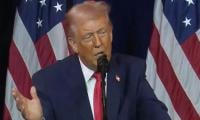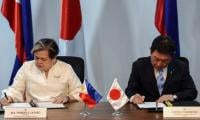Side-effect
Pakistan turned 62 yesterday. No less than fifty per cent of approximately 160,000 state-run primary
By Harris Khalique
August 15, 2009
Pakistan turned 62 yesterday. No less than fifty per cent of approximately 160,000 state-run primary schools in the country are without a boundary wall, toilet facility or electricity, only 22 per cent girls and 47 per cent boys complete primary schooling, 30 per cent of total children of school-going age receive secondary education, 19 per cent attend higher secondary schools and finally, tertiary enrolment is less than 5 per cent of the eligible age cohort (17-23). Yet again, a policy is announced by the Federal Ministry of Education, titled ‘National Education Policy 2009’.
The previous government had initiated a process of consultation in 2005 with different stakeholders on what the new education policy should look like and subsequently produced three drafts. The current one seems to be the final version to be submitted to and approved by the federal cabinet of ministers. Being dumb, repetitive morons, perhaps some of us would never understand that in a country which is governed by the insecure landed elite and a select few from the civilian and military bureaucracy, powers that be have no reason to pay heed to the voices of ordinary citizens.
Firstly, no real consultation is possible if a document is drafted in English language. How have the policy formulators consulted parents, teachers, students and common people in the length and breadth of Pakistan by circulating the draft of a somewhat technical nature in a language understood by a small minority of the country’s population, including our parliamentarians? But the issue is not just that. To be fair, parts of the document are well-written and well thought-out but there are some fundamental issues left unresolved and a new chapter added just a few days before publishing the policy on the net.
The problem of medium of instruction is not addressed, which means we would continue to see huge disparities and ever-widening gap between the rich and the poor. While impartation of language education on the whole is terribly weak and a large majority of our students is not proficient in any language, English is an insurmountable challenge for more than 90 per cent of our students. But the affairs of the state are run in English. No decent public or private sector jobs are available to those who study in state-run schools or cheap private schools, which are so-called English-medium. What a disconnect. We train the majority in a language which does not provide any decent livelihood because the country is run by the elite, and the elite and the affluent middle class speak English.
Another serious problem with the policy is the inclusion of an additional chapter on Islamic education without any consultation whatsoever. It begins with referring to the Objectives Resolution of 1949, pushed by the clergy of this country after Quaid-e-Azam’s death and made part of the 1973 constitution of the republic due to a pressure from those who wanted to convert Pakistan into a theocracy. It undermines the vision of the founding father, who clearly spelled out the need for building a modern, progressive and rational state where Muslims are in majority, and therefore their faith and practices are secured, but the rights of all citizens are equal and no sect or denomination has precedence over the other.
Zehra Arshad, who coordinates the Pakistan Coalition of Education, an independent network of educationists, civil society organisations and citizens, laments that the government refuses to learn from the blunders committed by Gen Ziaul Haq in the name of Islamisation. She says that the Shia-Sunni divide is rooted in the Islamiyat textbooks of Zia’s period. Policy must be revised.
The writer is an Islamabad-based poet and rights campaigner. Email: harris@spopk .org
The previous government had initiated a process of consultation in 2005 with different stakeholders on what the new education policy should look like and subsequently produced three drafts. The current one seems to be the final version to be submitted to and approved by the federal cabinet of ministers. Being dumb, repetitive morons, perhaps some of us would never understand that in a country which is governed by the insecure landed elite and a select few from the civilian and military bureaucracy, powers that be have no reason to pay heed to the voices of ordinary citizens.
Firstly, no real consultation is possible if a document is drafted in English language. How have the policy formulators consulted parents, teachers, students and common people in the length and breadth of Pakistan by circulating the draft of a somewhat technical nature in a language understood by a small minority of the country’s population, including our parliamentarians? But the issue is not just that. To be fair, parts of the document are well-written and well thought-out but there are some fundamental issues left unresolved and a new chapter added just a few days before publishing the policy on the net.
The problem of medium of instruction is not addressed, which means we would continue to see huge disparities and ever-widening gap between the rich and the poor. While impartation of language education on the whole is terribly weak and a large majority of our students is not proficient in any language, English is an insurmountable challenge for more than 90 per cent of our students. But the affairs of the state are run in English. No decent public or private sector jobs are available to those who study in state-run schools or cheap private schools, which are so-called English-medium. What a disconnect. We train the majority in a language which does not provide any decent livelihood because the country is run by the elite, and the elite and the affluent middle class speak English.
Another serious problem with the policy is the inclusion of an additional chapter on Islamic education without any consultation whatsoever. It begins with referring to the Objectives Resolution of 1949, pushed by the clergy of this country after Quaid-e-Azam’s death and made part of the 1973 constitution of the republic due to a pressure from those who wanted to convert Pakistan into a theocracy. It undermines the vision of the founding father, who clearly spelled out the need for building a modern, progressive and rational state where Muslims are in majority, and therefore their faith and practices are secured, but the rights of all citizens are equal and no sect or denomination has precedence over the other.
Zehra Arshad, who coordinates the Pakistan Coalition of Education, an independent network of educationists, civil society organisations and citizens, laments that the government refuses to learn from the blunders committed by Gen Ziaul Haq in the name of Islamisation. She says that the Shia-Sunni divide is rooted in the Islamiyat textbooks of Zia’s period. Policy must be revised.
The writer is an Islamabad-based poet and rights campaigner. Email: harris@spopk .org
-
 YouTube Adds New Parental Controls For Teens, Limits Shorts Scrolling
YouTube Adds New Parental Controls For Teens, Limits Shorts Scrolling -
 Sarah Ferguson Takes Big Decision As Royal Lodge Eviction Looms
Sarah Ferguson Takes Big Decision As Royal Lodge Eviction Looms -
 Bruno Mars Leaves Taylor Swift Behind With Shocking Move
Bruno Mars Leaves Taylor Swift Behind With Shocking Move -
 Trump Administration Imposes 25% Tariff On Imports Of Some AI Chips
Trump Administration Imposes 25% Tariff On Imports Of Some AI Chips -
 Chinese Smartphone Makers Adjust Prices As Costs Go Up
Chinese Smartphone Makers Adjust Prices As Costs Go Up -
 Wikipedia Owner Signs AI Content Training Deals With Microsoft, Meta
Wikipedia Owner Signs AI Content Training Deals With Microsoft, Meta -
 Meghan Markle’s Real Feelings Revealed Amid UK Return Rumours
Meghan Markle’s Real Feelings Revealed Amid UK Return Rumours -
 Reese Witherspoon Issues Urgent Warning After Scammers Using Her Identity
Reese Witherspoon Issues Urgent Warning After Scammers Using Her Identity -
 XAI Restricts Grok Image Editing After Backlash From California And Europe
XAI Restricts Grok Image Editing After Backlash From California And Europe -
 ‘Disgraced’ Andrew’s Past Scandals Catch Up To His Daughters
‘Disgraced’ Andrew’s Past Scandals Catch Up To His Daughters -
 Amazon Rolls Out ‘sovereign’ EU-based Cloud To Address Data Privacy Concerns
Amazon Rolls Out ‘sovereign’ EU-based Cloud To Address Data Privacy Concerns -
 Ross, Matt Duffer Used AI To Write Finale Of 'Stranger Things'?
Ross, Matt Duffer Used AI To Write Finale Of 'Stranger Things'? -
 Microsoft Secures Largest Ever Soil Carbon Credit Agreement Amid Data Centres Expansion
Microsoft Secures Largest Ever Soil Carbon Credit Agreement Amid Data Centres Expansion -
 Google Expands Gemini With Personal Intelligence
Google Expands Gemini With Personal Intelligence -
 Japan, Philippines Sign Defence Pacts As Regional Tensions Escalate
Japan, Philippines Sign Defence Pacts As Regional Tensions Escalate -
 ISS Crew Of Four Completes Medical Evacuation With Safe Splashdown Off California
ISS Crew Of Four Completes Medical Evacuation With Safe Splashdown Off California



